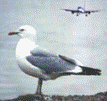Bird Strike Committee Proceedings

Bird Strike Committee-USA/Canada Joint Annual Meeting: 8th (2006)
Date of this Version
August 2006
Document Type
Article
Abstract
Prey manipulation was investigated as a means of reducing the bird hazard at the Bloemfontein airport, central South Africa. From January 1985 to December 2005 approximately 7,000 individuals representing 55 bird species which, potentially, posed a threat to aviation, were collected at the airport. Numerically the crowned plover (Vanellus coronatus), blacksmith plover (V. armatus), lesser kestrel (Falco naumanni), white-winged korhaan (Eupodotis afraoides) and double-banded courser (Smutsornis africanus) in order of importance constituted more than 90% of the total sample. Based on stomach analyses harvester termites (Hodotermes mossambicus) comprise the dominant food source of all five species concerned. Experimentally a significant and sustainable decrease in termite numbers and activities in disturbed grass areas could be accomplished by administering bait treated with Gaucho, a systemic insecticide. By using a combination of pitfall traps, mouse traps and sweep nets over a period of 15 months, prey abundance in undisturbed long grass (average 57 cm) and grass which were kept permanently short (average 22 cm) by regular mowing was compared. Terrestrial invertebrates, mainly insects, contributed more than 90% of the overall sample with twice as many individuals in short grass than in long grass. The available food source for the predominantly insectivorous avifauna at the Bloemfontein airport can thus be effectively reduced by implementing a so-called long grass policy in combination with seasonal chemical control of harvester termites, thereby limiting bird numbers and also bird strikes.

